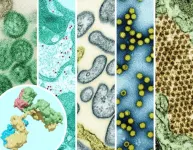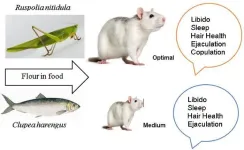(Press-News.org) While planting trees may seem like an easy win to combat climate change, planted forests often encroach on natural forests, wetlands, and grasslands. This can reduce biodiversity, disturb the natural environment, and disrupt carbon and water cycling. While there has been a global increase in forest cover, it’s hard to know if this forest is the regeneration and growth of natural forests or if it is planting new trees. Accurately mapping these forests with remote sensing technology could help.
However, comprehensive maps of planted forests and natural forests are lacking even though it is possible to distinguish planted forests and natural forests on satellite images based on their characteristics. A new study published on 21 August in the Journal of Remote Sensing presented an innovative approach to automatically generate training samples so natural forests and planted forests can be accurately mapped at 30-m spatial resolution.
“Accurately mapping the global distribution of natural and planted forests at a fine spatial resolution is a challenge, but it is crucial for understanding and mitigating environmental issues such as carbon sequestration and biodiversity loss,” said Yuelong Xiao, a doctoral student at the College of Surveying and Geo-Informatics at Tongji University in Shanghai, China. “Traditional methods often lack sufficient training samples, which hampers the accuracy and resolution of global forest maps. Our study presents a novel approach to overcome this limitation by generating extensive training samples through time-series analysis of Landsat images.”
The researchers sourced data from several different mapping systems. The primary sources were Google Earth Engine’s Landsat images ranging from 1985 to 2021 that were preprocessed by the US Geological Survey and images from the Sentinel-1 satellite from 2021. They also used the 2021 European Space Agency land cover maps, called WorldCover2021, and data from the ALOS Global Digital Surface Model. To work around computing limitations, researchers divided the globe into small tiles, resulting in 57,559 tiles covering the entire globe and 70 million training samples.
To distinguish between established natural forests and planted forests, researchers used a value called the frequency of disturbance. Natural forests are more stable and are less likely to change in size based on external factors. In comparison, planted forests are more likely to be disturbed through reforestation or deforestation and other natural and manmade changes. By tracking the frequency of disturbance of a forested area on a satellite image, natural forests and planted forests can be identified.
Planted forests were considered pixels with a frequency of disturbance value greater than three. The value was calculated based on the number of disturbance events, such as planting events, and the reliability of the training samples. Natural forests had no disturbance events. Researchers also accounted for the fact that all of their images were from 1985 and later. To account for planted forests that may be older than 1985, they used other features and characteristics to distinguish between natural and planted forests. Finally, to determine the accuracy of their training model, researchers compared their natural vs. planted forest maps with other studies.
The research demonstrated that a less labor-intensive mapping method using autogenerated training samples to distinguish between natural and planted forests is possible. “This method to accurately map natural and planted forests globally at a 30 meter resolution is reliable and the generated map and training samples represent a valuable resource for future research and environmental management, contributing to efforts in combating climate change,” said Xiao.
Looking ahead, researchers are hoping to integrate improvements into the map system. “Next, we will use the generated training samples and method mapping to update and refine the global map of natural and planted forests regularly. Our ultimate goal is to enhance the accuracy and resolution of forest maps worldwide, providing critical data for policymakers and researchers,” said Xiao.
Other contributors include Qunming Wang at Tongji University in Shanghai, China and Hankui K. Zhang at South Dakota State University in Brookings, South Dakota.
The National Natural Science Foundation of China supported this research.
END
Using training model to map planted and natural forests via satellite image
2024-09-14
ELSE PRESS RELEASES FROM THIS DATE:
Illinois Institute of Technology Architecture Programs earn National Sustainability Designation from U.S. Department of Energy
2024-09-13
CHICAGO—September 13, 2024—The College of Architecture at Illinois Institute of Technology has been awarded the prestigious Zero Energy Design Designation (ZEDD) from the United States Department of Energy (DOE) for it Bachelor of Architecture and Master of Architecture programs. This recognition highlights the college’s commitment to sustainability, carbon neutrality, and zero-energy design practices in a world of escalating extreme weather and climate change.
The ...
Rice research could make weird AI images a thing of the past
2024-09-13
HOUSTON – (Sept. 13, 2024) – Generative artificial intelligence (AI) has notoriously struggled to create consistent images, often getting details like fingers and facial symmetry wrong. Moreover, these models can completely fail when prompted to generate images at different image sizes and resolutions.
Rice University computer scientists’ new method of generating images with pre-trained diffusion models ⎯ a class of generative AI models that “learn” by adding layer after layer of random noise to the images they are trained on and then generate new images by removing the added noise ⎯ could help correct ...
NIH awards establish pandemic preparedness research network
2024-09-13
The National Institutes of Health (NIH) has established a pandemic preparedness research network to conduct research on high-priority pathogens most likely to threaten human health with the goal of developing effective vaccines and monoclonal antibodies. Currently, many of the diseases caused by these pathogens have no available vaccines or therapeutics, and investing in this research is key to preparing for potential public health crises—both in the United States and around the world. NIH’s National Institute of Allergy and Infectious Diseases (NIAID) expects to commit approximately ...
$3.9 million grant accelerates UVA professor's efforts to detect Alzheimer’s early
2024-09-13
University of Virginia professor Mathews Jacob has secured a $3.9 million grant to advance his innovative research on detecting Alzheimer’s disease in its early stages. Jacob, who specializes in electrical and computer engineering, is teaming up with researchers from the University of Iowa and the University of California-San Francisco to push the boundaries of imaging technology that tracks the brain’s metabolic changes — offering a fresh perspective on studying neurodegenerative disorders.
Their focus is on advancing magnetic resonance spectroscopic imaging (MRSI). Unlike standard MRI, which primarily highlights structural changes, ...
Flowers use adjustable ‘paint by numbers’ petal designs to attract pollinators
2024-09-13
Flowers like hibiscus use an invisible blueprint established very early in petal formation that dictates the size of their bullseyes – a crucial pre-pattern that can significantly impact their ability to attract pollinating bees.
The study, by researchers at the University of Cambridge’s Sainsbury Laboratory also found that bees prefer larger bullseyes over smaller ones and fly 25% faster between artificial flower discs with larger bullseyes – potentially boosting efficiency for both bees and blossoms.
Patterns on the flowers of plants guide insects, like bees, to the centre of the flower, where nectar and pollen await, ...
Men behind the wheel: Three times more violations and accidents than women
2024-09-13
Men are three times more likely than women to commit traffic violations while driving and to be involved in accidents. Moreover, they are more likely to create situations on the road that are highly dangerous to others. Men are also twice as likely to drive under the influence and nearly one-third more likely to receive a prison sentence for reckless driving. Perhaps it comes down to cultural norms and the different attitudes men and women have toward driving. These are the conclusions reached by Anton Kazun, Assistant Professor at the HSE Faculty of Economic Sciences, and Research Assistant Mikhail Belov.
There is a stereotype that women are worse driver than men; female drivers are ...
Research alert: Technique to study how proteins bind to DNA is easily misused; New study offers solution
2024-09-13
Researchers at University of California San Diego have published new guidelines that could help scientists significantly improve their results when quantifying the interactions between DNA and proteins. Understanding these interactions is critical to our understanding of human biology in general, and can also help scientists develop new treatments for a wide range of diseases, including many cancers.
The researchers focused on spike-in normalization, a widely-used molecular biology technique that helps ensure accurate and reliable results. Spike-in normalization involves adding a known quantity of chromatin (DNA and the associated proteins) to a sample before it ...
Edible insects show promise as sustainable nutritional source
2024-09-13
As the global population grows and traditional livestock production increasingly strains environmental resources, there is a rising interest in alternative protein sources. Edible insects, particularly grasshoppers, are abundant in regions like Cameroon and provide essential nutrients, including proteins, amino acids, and minerals vital for health and growth. Addressing these challenges calls for in-depth studies on the nutritional benefits of insects such as Ruspolia nitidula.
Conducted by the University of Dschang, Cameroon, and published (DOI: 10.26599/FSAP.2024.9240068) in the journal Food Science of ...
Machine learning could help reduce hospitalizations by nearly 30% during a pandemic, study finds
2024-09-13
A new study sheds light on a promising approach using machine learning to more effectively allocate medical treatments during a pandemic or any time there’s a shortage of therapeutics.
The findings, published today in JAMA Health Forum, found a significant reduction in expected hospitalizations when using machine learning to help distribute medication using the COVID-19 pandemic to test the model. The model proves to reduce hospitalizations relatively by about 27 percent compared to actual and observed care.
“During the pandemic, the healthcare system was at a breaking point and many health care facilities relied on a first-come, first-serve or a patient’s ...
E-cigarette brands are skirting the rules about health warning labels on Instagram
2024-09-13
Island breeze, blue lagoon, dew drop—these aren’t the names of scented candles on display at your local home goods store. They’re flavors of synthetic nicotine used in e-cigarettes, often advertised with neon-electric colors and bright lettering to make them look like boxes of candy or fruit juice. But underneath all the flair, a specific label written clearly in black text on a white background is required by law to be there: a warning that says the product contains nicotine and that nicotine is an addictive substance.
Even though health warnings need to be written on physical products sold in stores ...






